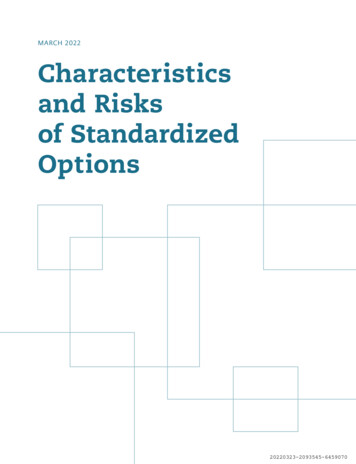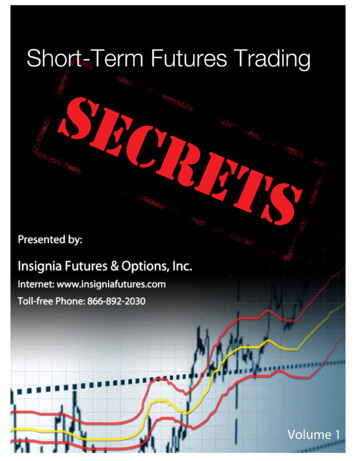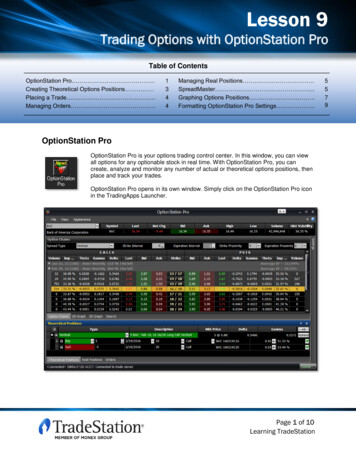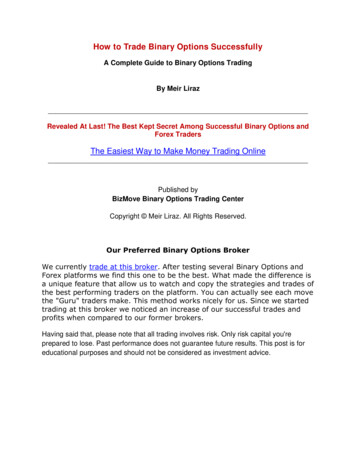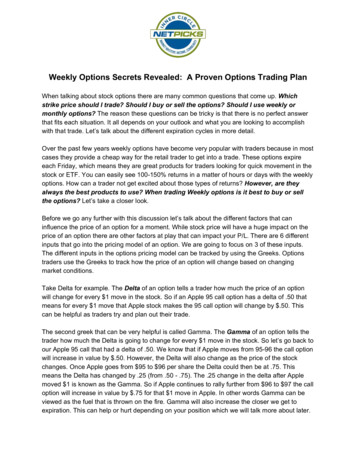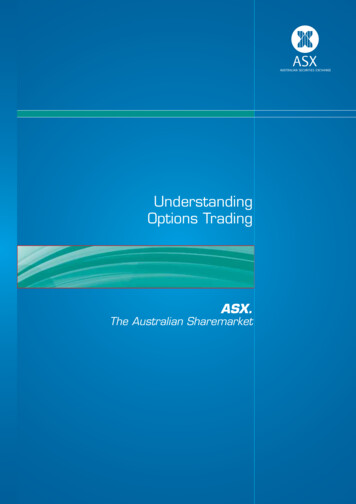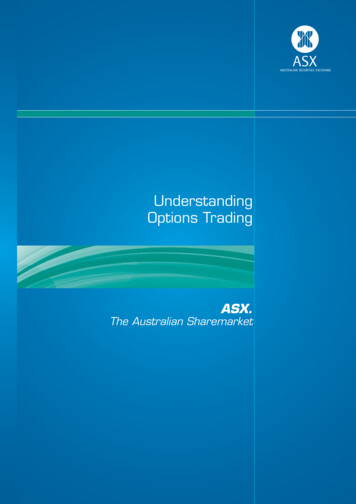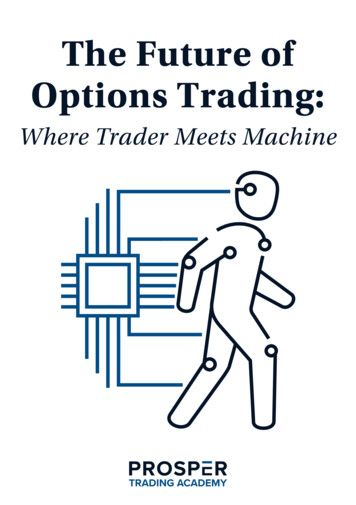
Transcription
The Future ofOptions Trading:Where Trader Meets Machine
The Future of OptionsTrading: Where TraderMeets MachinebyMichael Shorr&Prosper Trading Academy
DAY TRADING involves high risks, andYOU can LOSE a lot of money. Hypotheticalor simulated performance results havecertain inherent limitations. Unlike an actualperformance record, simulated results do notrepresent actual trading. Also, because the tradesactually have not been executed, the resultsmay have under-or over-compensated for theimpact, if any, of certain market factors, suchas lack of liquidity. Simulated trading programsin general also are designed with the benefitof hindsight. No representation is being madethat any account will or is likely to achieveprofits or losses similar to those talked aboutin our site. The information contained hereinis specifically for the limited personal use ofthe individual who purchased this course. Anyreproduction, dissemination or retransmissionof the information contained in this course isstrictly prohibited without the express writtenpermission of Prosper Trading Academy LLC. 2018 Prosper Trading Academy
Why you need to study thiseBook!Options trading has been around since the early 1970’s.It has evolved from very basic strategies to the complexstrategies we are used to today. Believe it or not, whenoptions trading first came to the trading floors of Chicago,they didn’t even list put options. Are far we have comesince those days. Whether you are new to trading optionsor a seasoned professional, there is always more to learn.What our options instructors have found in our decades ofeducational experience is that many, if not most, traders aresimply not maximizing the potential of trading options. Weutilize proprietary trading methodologies and ARTIFICIALINTELLIGENCE technology to give us our edge!We are here to change that.1
What you will find in this eBook: What are options spreads? How to use capital allocation regimens to lessen thevariance of your returns. Employing risk management disciplines designed tomaximize your winning trades and mitigate your losingones. Avoiding the pitfalls of throwing good money at bad. How to utilize ARTIFICIAL INTELLIGENCE touncover directional options strategies! .and much more more.2
About the AuthorMichael ShorrSenior Options Instructor,Prosper Trading AcademySince 1994, Michael has been an on-the-floor market maker, VicePresident of Interest Rate Derivatives and options educator. He is theDirector Of Trader Education at Prosper Trading Academy and theInstructor in the Short Term Options Room at Prosper. He makesthe oftentimes complex world of options and trading accessible tothe novice and advanced trader alike. Michael has a Bachelor ofScience degree in Statistics and Finance from the University of IllinoisChampaign-Urbana.1
What Is An Options Spread?An option spread is a trading technique that involves tradingmultiple options (legs) at the same time. Typically, the spreadwill consist of two legs. Options spreads can have as manyas four legs. The types of spreads you will encounter in mymethodology will consist of equal weighting on both legs.We break our trades into two distinct categories: active andpassive.An active entry is based on the fact that you believe thatsomething IS GOING to happen. For example, you haveidentified that USO has broken out of its trading range andwe want to take advantage of the breakout.A passive approach signifies that you think something ISNOT GOING to happen. For example, you have determinedthat you believe that a stock or ETF has found support orresistance. You think IT IS NOT going to move through thatsupport/resistance level. Let’s explore each.2
ACTIVE ENTRYLike we discussed, we think something IS GOING tohappen. We don’t mind paying a debit if we can be properlycompensated for the risk. We are looking for a minimumof 2:1 reward to risk. This is typically accomplished bypurchasing a vertical call spread or vertical put spread. Anexample of this would be: let’s say that we have identified thatUSO has broken out to the upside at 14.50. Let's assume ourtarget price is at 16.00. You want your short strike of yourvertical to be the that target price. Then you want to find thelowest strike that still affords you at least a 2:1 reward to riskratio. Your time to expiration should be no shorter than 4trading days and no longer than 10 trading days. So, in thiscase if we buy the two week out 15/16 call vertical for 0.33or less. This would satisfy our risk parameters.3
PASSIVE ENTRYWe characterize a passive entry as a set up where we thinksomething is NOT GOING to happen. The stock or ETFhas traded to support/resistance levels. We do not necessarilybelieve that the stock is going to turn around and do amassive retracement, but we feel confident in the fact thatthe support/resistance levels will hold. A passive approachwould make a lot of sense here. A set up like this looks toprofit from the fact that the stock will not break through theidentified s/r. A credit spread makes sense for this type of setup. Here you want your short strike to be the price level thatyou think will be defended. Then choose your debit strike toadhere to the risk reward parameters you have set.4
Capital AllocationBefore you can even consider putting on an options trade, youhave to address the concept of capital allocation. Optionstrading, specifically options spread trading, is different thanother types of trading. You may hear a trader say: “I trade10 lots of Crude Oil futures” or “I am a two lot e-mini S&Ptrader” or things along that line. That is because traderslike these measure their risk in ticks. A tick is the minimumamount that an underlying contract can move. For example,in Crude Oil, a future can move one cent ( 0.01) at a time,like from 50.50 to 50.51. In pure dollar terms, thattranslates into 10 per one-cent move. However many lotsthat trader trades at one time is their risk per trade. That ticksize is a constant value. The size of the tick never changes.This type of trader measures their risk in what they arewilling to make or lose on a certain price movement. Thatdetermines the amount of lots they trade.That is not the case for an options spread. The price ofan option spread depends on many things. Let’s take theexample of an equity option. The options spread has manyvariables, but it all comes down to dollars at risk. Evenif we are talking about two different spreads in the sameunderlying, the allocation will be different. Let’s look at anexample in Facebook (FB). Let’s look at two call spreads withthe same strikes, but different expiration dates. Considerthe June 175/180 call spread that is trading 1.80 and theJanuary 175/180 call spread which is trading 2.25. In orderto to have the same dollars at risk for each trade, we can trade5
more of the June spread than we can trade of the Januaryspread. The June costs less. As a rule, I allocate 3% of myaccount value to any given signal. With the example of a 25,000 trading account, 3% represents 750 of capital atrisk. For the June spread trading 1.80, that means that a onelot will cost 180.00. To allocate 750 of capital risk meansthat I can trade 4.17 lots of that spread (you cannot tradefractions of an options contract or options spread, but this isjust a theoretical example). Using the same calculation, I caninvest in 3.33 January spreads ( 750/ 225). In each case, Ihave the same dollars at risk which will help to smooth outthe variance of my returns.6
Risk ManagementOnce you are in your trade you have to manage your risk.First, we manage where we are going to stop ourselves outin the case of a losing signal. I teach that you should stopyourself out when your spread has lost 50% of its value. Forexample if we paid 1.80 for the June 175/180 call spreadin our FB example above, we would stop ourselves out andrealize a loss when our spread was worth 0.90. Next, youhave to define your winning exit strategy. I teach that youshould start to take your winners off the table when yourspread increases by 70%. In this case our exit signal wouldbe set for 3.06 ( 1.80*1.7 3.06). The parameters you setare aligned with your own risk tolerance. What is importantis that you allow your winners to run a little bit and have yourstop-loss parameter less than your winning parameter. Youcannot take profit when you realize a 10% profit and let yourlosers go to a 100% loser. That is formula for failure.7
Throwing Good Money At BadI am often asked about “rolling” or “adjusting” signals thatare not working out. In all but the most rare circumstances,my answer is a resounding “No!” Why is that? In all myyears of training clerks who were trying to become tradersand students who are trying to learn about trading, one factorwas prevalent in almost all failures. That factor was thatperson’s unwillingness to realize a loss. You could be a mathgenius. You could be a street-savvy scrapper. People fromall walks of life and backgrounds proved that they had theaptitude to trade. But, if they could not manage their riskby know when to cut bait and acting on it, it meant tradingdoom. “Rolling” and “adjusting” are just fancy ways of notrealizing a loss. There is an old trading joke. “It’s not a loseruntil you get out!” That’s true. You do, however, run thevery significant risk that you turn a small loser into a hugeproblem. Your time, effort and money would be far betterspent looking for a new opportunity than to try and chase alosing trade and break even. If you lose money in a FB trade,does it make a difference whether you make that money backin FB or any other stock? It does not matter where you makeyour money. The only thing you should concern yourselfwith is finding the best opportunity to be profitable, notrevenge trading in a stock that you got wrong.8
Using Artificial IntelligenceTo Identify Options TradingOpportunitiesI use a trading platform call VantagePoint. I use aproprietary combination of predictive moving average crossovers, neural indexes, predictive ranges and momentumindicators to formulate buy and sell signals and then apply myproprietary options methodologies to leverage the signal.VantagePoint uses neural networks to identify which globalmarkets have the most influence on a target market, thenproduces a set of intermarket data to generate predictivetechnical indicators that give you short-term price and trendforecasts. Most trading tools focus on past-price data that’salready occured. VantagePoint applies an AI Neural Networkto forecast market data, allowing me to get into trades daysbefore other traders know what’s happening. The predictiveindicators give you a head start on trend changes.9
Before you can even consider putting on an options trade, you have to address the concept of capital allocation. Options trading, specifically options spread trading, is different than other types of trading. You may hear a trader say: "I trade 10 lots of Crude Oil futures" or "I am a two lot e-mini S&P trader" or things along that line.

